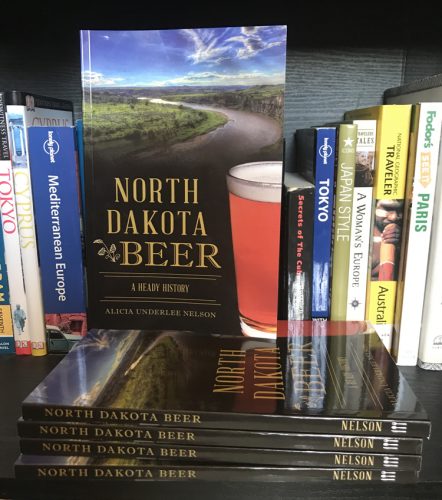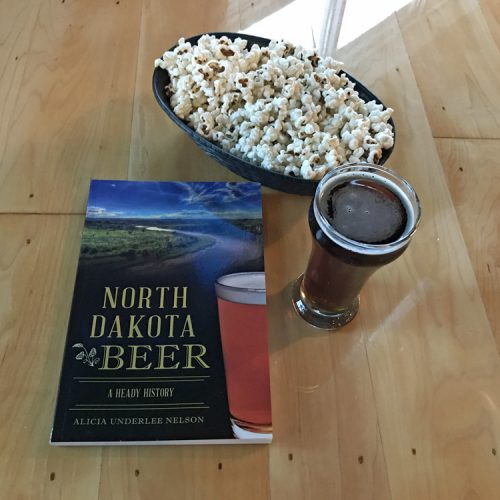By Tracie Bettenhausen
Photos submitted
When Alicia Underlee Nelson clicked “send” on her proposal to write a book about North Dakota beer, she knew her journalistic curiosity was going to be helpful, but she didn’t realize the endurance she would need to keep her project moving. The Fargo, North Dakota-based author recently told Inspired Woman writer Tracie Bettenhausen about her experiences researching, writing, and sharing the 2017 book, “North Dakota Beer: A Heady History.” Here’s how it all came together in Alicia’s own words.

Alicia Underlee Nelson
HISTORY
Beer was illegal here in North Dakota for a really long time. But that doesn’t mean we stopped drinking it, at all. People weren’t writing down all the illegal activity they were doing in ways that were easily traceable, but all these stories still exist and many of them you had to look a little bit for.
I remember looking through town centennial books, letters, and oral histories, and I was sitting on the floor of a library — it was almost closing time — and thinking, “It would be so nice if somebody would just compile all of these little things into a comprehensive list.” And I stopped, and I was like, “Oh my goodness, that’s me. That’s what this is.”
I don’t think I comprehended how huge this project was until right then. I was seriously sitting there with the artifacts and books and boxes all over at my feet, and the librarian was doing the five minute call that they’re going to be locking up, and I’m like, “OK, I have to really kick it into the next gear here and write this.” It gave me a new purpose and really helped me power through.
ARTIFACTS
Almost everything that exists and that can be backed up by multiple sources on the subject of beer in North Dakota is the work of one man. His name is Frank Vyzralek, and he worked for the State Historical Society of North Dakota.
I went to the state archives in Bismarck and walked up to the front desk and said, “I would like you to bring these two things up for me.” And the gentleman smiled this mysterious smile, and said, “Just those two?” I said, “Yeah, I hope they give me some direction.”
He sort of gave me a look because he knew a lot more than I did because he knew Frank, and he knew his passion was beer. He brought up two carts full of boxes that were full of the notes from exhibits in the State Historical Society. But these boxes also had bar napkins and clippings from newspapers and notes on scratch paper and just sort of general interviews scribbled down and question marks behind addresses. It was his absolute raw research.
A lot of the records for the time period I needed, roughly the 1940s-1990s, are not really old enough to be in a museum yet, but not new enough to be catalogued on the web.
So, I talked to people about their memories. What was it like before women were legally allowed to drink? What was it like before Native Americans were legally allowed to drink? Who went to this bar? When was beer consumed?The people I talked to made this book a lot more interesting, a lot more rich. And my goal always was for me as a narrator to speak as little as possible. I don’t think me summarizing how a soldier or cowboy spent his money is nearly as interesting as hearing directly from those people themselves.
CROSS-CHECKING THE FACTS
I had a hard time knowing when I had researched enough. I was terrified there would be a brewery that pops up that I didn’t know about. I wanted everything verified three different ways, accurate, fact-checked, cross-checked, especially for the new assertions I was making. For example, I was in the Hjemkomst Center in Moorhead, Minnesota, in the basement, and pulled an old Tidbits magazine, which was a fun little ad thing that you page through before dinner. It was squished in the back of the filing cabinet. And it happened to be in there, and I happened to find it, and I happened to look at it, and I happened to find the last supporting source that I needed for a 1990s-era Fargo brewery I was researching.
THE BOOK
The book is equal parts history, equal parts beer, kind of told as a drinking story. You go down to the local brewery for a beer with your friends, and now you know there was a brewery a lot like this 100 years ago. It gives you a deeper experience.
I think great writing needs to make you look at your world a little differently. There is something about learning about history in a place where it actually happened that kind of becomes hard to ignore.
SHARING THE STORIES
It was an absolute blast to present a Civil War-era soldier story at Fort Abercrombie, and to tell those funny stories just steps from where those guys actually lived. It’s also fun to be out in Germans-from-Russia country, on the Lawrence Welk homestead, and talking about brewing with subjects in my book that people in the room actually knew. I had interviewed a female brewer. Not only was that terrifically unusual and rare to have documented in a book, but the audience knew of the practice, had people in their own lives who brewed beer in the same way, and also they knew the subject in the book. That’s a North Dakota thing and that would happen all the time.
CONTINUING THE STORY
There will be a second edition to this book because I am learning so much from people as I tell these stories. They are able to fill in the blanks, verify things I had heard but couldn’t verify through records.

I want this book to give you that feeling where you are sitting in a quiet room all by yourself and you just laugh. That sense of discovery and “What are these people thinking? I love it.” I don’t care if you think it’s right or wrong or moral or not, that’s people and that’s human nature. People are surprising.
Tracie Bettenhausen is a senior staff writer/editor at Basin Electric. She has generously opened her home to two once-foster, now-adopted kitties, Basil and Sweet Pea.
